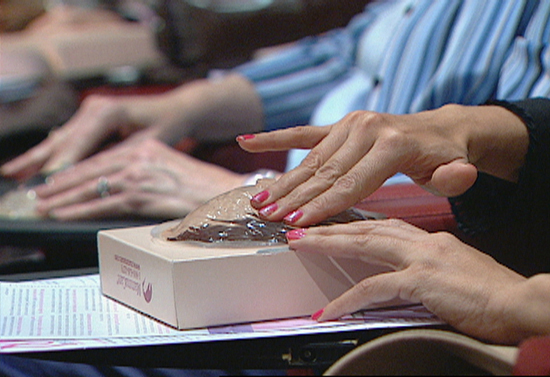
So you understand how to reduce your risk factors for breast cancer; you regularly perform your BSE (breast self exam) and you attend your annual clinical breast exam. Yet every woman still dreads that “lump in breast” scenario. The concept that all breast lumps are cancer is one of the common breast cancer myths, probably arising from fear and lack of information.
If you do find a lump in your breast, however, don’t panic. According to the American Cancer Society, four out of five biopsies of breast lumps are benign, meaning that they are harmless and certainly not breast cancer.
Breast Lump Types
There are four types of breast lumps, classified by their cause, or etiology:
- Fibroadenoma—a type of benign mass that occurs most often in young women. It is usually very mobile.
- Breast cyst—like cysts elsewhere in the body, breast cysts are benign fluid-filled lumps. They occur most often in women near menopause.
- Other benign fibrocystic masses—a benign combination of a fibrous mass, like that of a fibroadenoma, and a cyst.
- Breast cancer—while not true in all cases, cancerous lumps are usually painless and firmer than cysts and fibroadenomas.
Causes of Benign Breast Lumps & Painful Breast Lumps
Good news! If your lump is painful, it is likely not breast cancer. There are actually a lot of possible explanations for lumps in your breasts besides cancer:
- Normal hormonal breast tissue changes
- Breast infection (mastitis)
- Fatty lumps formed as a result of trauma
- Some medicines can cause breast lumps
- Certain conditions: Fibrocystic breasts; benign cysts; fibroadenomas; intraductal papillomas – most of these are types of hard or rubbery lumps in the milk ducts and surrounding breast tissue, strongly related to the menstrual cycle and hormone levels.
Many of these are related to natural hormone cycle changes, with some women simply more susceptible to breast lumps than others. Sometimes lumps come and go in cycles or are more temporary due to injury, infection or medication. Benign breast lumps usually have smooth edges and will move around slightly when pushed against. They are often found in both breasts.
What To Do If You Find A Breast Lump
This is not to say that finding a lump, thickening or change in your breast of any kind is not serious. For anybody who finds a lump in their breast, that 20% chance that it could turn out to be cancerous is understandably enough to cause real anxiety… which is not actually a bad thing. That uncertainty should drive you to get any lump or change in your breast tissue—however slight—checked out by your doctor right away.
It is always better to be told that everything is fine and to have your mind put at ease than to leave it too late, especially as the earlier breast cancer is detected and identified, the higher the chance of successful treatment.
It is important to not only get really familiar with how your own breasts feel through performing a breast self exam but to do this regularly. As many of the benign breast lumps are strongly linked to the menstrual cycle and present more at certain times of the month, you ideally need to be aware of how your breasts feel during different stages where you may have perfectly ordinary lumps. Recognising what is “normal” for your breasts at different times can be key to quickly identifying a lump which isn’t typical, should it occur.
Remember: although there is most likely no reason to worry, a breast lump should never be ignored. If in doubt, seek a clinical breast exam from an experienced healthcare professional who can arrange a mammogram if necessary.
